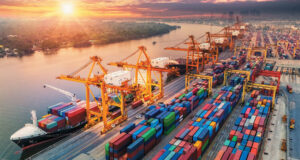Ports around the world are facing increased security threats. Some threats are physical, but others are from ultra-suave computer hacking. As a result, security and technology personnel are stepping up their efforts to help ports, terminals and their supply chains mitigate risk.
By Kathy A. Smith

Ports around the world are facing increased security threats. Some come in the form of terrorist attacks and active shooters, others from drones, improvised explosive devices (IEDs), and ultra-suave computer hacking. As a result, security personnel and technology are stepping up their efforts to help ports, terminals and their supply chains mitigate risk.
Physical Security
“On top of standard security efforts to secure the ports, a lot of seaports are worried about soft targets (large or vulnerable crowds of people), with a main one being cruise terminals. Some ports are having to adjust to cruise lines getting much more efficient in terms of onloading and offloading crews and travelers,” said Coleman Maness, account manager for ARES Security Corporation, experts in security and response optimization. Obviously today, the cruise ship industry is not operating under normal circumstances as a result of COVID-19. Still, security threats abound.
“Traditional security in a maritime port pre-9/11 may have included one guard on the entrance, one on the exit, one rover and two people screening cruise ship passengers,” explained Robert Wheeler, ACE, vice president of aviation/maritime ops, national government services for Allied Universal (AUS), which serves 19 seaports and 10 port authorities in North America. “Now it’s entire fences being barb-wired, three guards per check and inspections of vehicles and people; analysis and the penetration checking of credential checkpoints has really gone through the roof.” In fact, while the effects of COVID-19 has seen many businesses across industry sectors close or be reduced to minimum staffing levels, Wheeler said AUS is scrambling to hire more security personnel.
Another trend that’s taking hold in physical security is real-time data. New technology is enabling security personnel to work with real-time intel with a number of alerts and “hit lists” that are programmed into smart phones, increasing robust situational awareness. For example, as a security guard approaches a certain area at the port, the system will alert them that there was a previous breach in the fence, initiating a service request for the guard. The technology is run through GPS. “In some ports, we also piggyback on homeland security activities, including CCTV watch standing,” said Wheeler about AUS’ security platform, HELIAUS®.
Artificial intelligence is also being used to conduct incident reports. “When there is a new facility planned at a port authority, the technology generates an artificial intelligence, live-by-the-day watch plan for the security officer,” said Wheeler. “It will redirect them to different areas if we have a cargo ship coming in with an operation that needs a security measure done, and will direct security patrol based on entered parameters, coordinate with the supervisors and port authority as to what checks are being done in real time.”
 AAPA Seaports
AAPA Seaports


